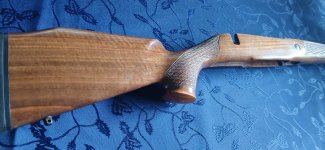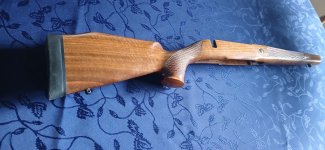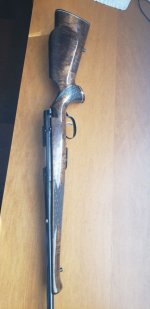You are using an out of date browser. It may not display this or other websites correctly.
You should upgrade or use an alternative browser.
You should upgrade or use an alternative browser.
Boiled vs double boiled linseed oil
- Thread starter Light Infantry
- Start date
I've used Boiled version raw for early stock work and Boiled with a small qty of mineral spirits on later stocks. Minimal qty goes a long ways as I'm sure you already know. Waiting 2 weeks for it to dry teaches a guy to use it sparingly. 45 mins to an hour to hand rub it as deep as possible. Hang til no tackyness and repeat procedure until you're happy. I was usually in the 6-8 coats range.Didn't give it much thought in the past. But now thinking of getting a Boyd's walnut stock and using the linseed oil. Which one should you use?
Also considering tung oil.
I've used tung once. Decent results. Nowadays I've moved to trying different oils, 10-12 applications. and additional 3-4 steps to finish things off that I'm very happy with.
I would suggest a product made for gun stocks; Lin-Speed Gun Stock Finish or Tru Oil Stock Finish. Both are considerable better than Linseed Oil, Boiled Linseed Oil, or Multiple Boiled Linseed Oil.
Lin-Speed is an extreme grain revealing finish oil for gunstocks and any fine woodwork, like furniture, guitars, wood knife handles, pens, bar tops, and much more. Lin-Speed deeply penetrates wood pores and hardens, protecting the wood and revealing the beauty of grain patterns from within.
Easy-to-use Tru-Oil brings out the warm, natural beauty of a wood stock and gives it the look of a deep, rich, hand-rubbed finish without the hassle. It requires an average of only three coats and dries so fast - 90 to 120 minutes per coat - that a stock can be finished in one day! Tru-Oil is a purified triple-processed blend of all-natural oils that penetrates into the grain to seal out moisture. Won’t yellow or cloud the grain, and the surface becomes harder and tougher. Apply multiple coats to produce a high-gloss finish, or for a more subdued satin finish, cut back the gloss with fine steel wool or rubbing compound, then apply Birchwood Casey Stock Sheen & Conditioner (sold separately). Tru-Oil is perfect for refinishing existing stocks; for an unfinished stock, first apply Birchwood Casey Clear Sealer & Filler. Minor scuffs and marks on a stock finished with Tru-Oil are easily fixed: just rub the spot gently with a pad moistened with Tru-Oil.
Lin-Speed is an extreme grain revealing finish oil for gunstocks and any fine woodwork, like furniture, guitars, wood knife handles, pens, bar tops, and much more. Lin-Speed deeply penetrates wood pores and hardens, protecting the wood and revealing the beauty of grain patterns from within.
Easy-to-use Tru-Oil brings out the warm, natural beauty of a wood stock and gives it the look of a deep, rich, hand-rubbed finish without the hassle. It requires an average of only three coats and dries so fast - 90 to 120 minutes per coat - that a stock can be finished in one day! Tru-Oil is a purified triple-processed blend of all-natural oils that penetrates into the grain to seal out moisture. Won’t yellow or cloud the grain, and the surface becomes harder and tougher. Apply multiple coats to produce a high-gloss finish, or for a more subdued satin finish, cut back the gloss with fine steel wool or rubbing compound, then apply Birchwood Casey Stock Sheen & Conditioner (sold separately). Tru-Oil is perfect for refinishing existing stocks; for an unfinished stock, first apply Birchwood Casey Clear Sealer & Filler. Minor scuffs and marks on a stock finished with Tru-Oil are easily fixed: just rub the spot gently with a pad moistened with Tru-Oil.
Definitely sand before first coat and take all dents out with iron and moist towel. First sand 80 grit, then 200, then 400. YMMV. Between coats of oil it doesn't hurt to very lightly scour with 0000 steel wool. Just enough to remove imperfections like dust etc. Wipe off dust created with Tack cloth.Sand before 1st coat and then sand between coats? And I mean slight sanding to get the grain up i.e. just scuff it up.
Sorry, its been a long long time since I have done this
Don't use pure tung oil, takes forever to dry if in fact it really dries. Most Tung oil sold now has additives. But you can get pure Tung oil at Lee Valley
Personally I would use "clear #66" which is a Varathane sealant. I redid a guys Win100 in it and it looked great.
My understanding is this is what a major firearms Co used to use. I could be wrong.
Personally I would use "clear #66" which is a Varathane sealant. I redid a guys Win100 in it and it looked great.
My understanding is this is what a major firearms Co used to use. I could be wrong.
Attachments
All good but he'll need to work fast. That's where a little mineral spirits helps slow things down. Nice thing about Tru Oil us being able to stay with the high gloss finish or matted down a few notches with the steel wool. A coat of HQ wax like Renaissance and a good buff is a recommended finishing off
Thanks for all the info, but i think I need to clarify a few things. This is for a new musurp stock from Boyd's. I.e. a Garand. So I'm trying to stay towards "original" type finishes with less shiney/gloss look.
BLO and tung oil where used on Garands among other military rifle during that time period.
BLO and tung oil where used on Garands among other military rifle during that time period.
Last edited:
Light Infantry, I suggest, after sanding, use the finest steel wool you can find to smooth out the finish even further.
I go to the Dollar Store and pick up packages of ten small rolls, which are the perfect size already, and you don't have to pull/cut them apart, causing dust or strings.
I also like Lin-Speed as a stock finish, but it can be too shiny for some folks and is best applied to warm wood, while the product is warm, wearing disposable rubber gloves and a cloth without lint.
I have nothing against Linseed Oil, but it takes forever to get enough applications on to give you similar results to Lin-Speed.
One thing I do with both Linseed Oil as well as Lin-Speed is to cut it with Acetone, 1 part Linseed/Lin-Speed/ 5 parts by volume Acetone.
The Acetone allows the coatings to go on much easier, and allows faster/deeper penetration/sealing, as well as accelerates the drying process exponentially.
Sanding isn't required between coats, because the Acetone slightly melts the previous coat and blends.
The Acetone allows the finish to blend perfectly, without any high spots in the finish left behind after the Acetone evaporates.
I find using Linseed Oil for the finish, it will have a slightly matte finish, if it isn't "rubbed in"
Lin-Speed finishes shiny, but that can be toned down with some very light sanding with fine steel wool and rubbing with your bare hands later.
Lin-Speed is similar to Tung Oil, but works better IMHO.
I go to the Dollar Store and pick up packages of ten small rolls, which are the perfect size already, and you don't have to pull/cut them apart, causing dust or strings.
I also like Lin-Speed as a stock finish, but it can be too shiny for some folks and is best applied to warm wood, while the product is warm, wearing disposable rubber gloves and a cloth without lint.
I have nothing against Linseed Oil, but it takes forever to get enough applications on to give you similar results to Lin-Speed.
One thing I do with both Linseed Oil as well as Lin-Speed is to cut it with Acetone, 1 part Linseed/Lin-Speed/ 5 parts by volume Acetone.
The Acetone allows the coatings to go on much easier, and allows faster/deeper penetration/sealing, as well as accelerates the drying process exponentially.
Sanding isn't required between coats, because the Acetone slightly melts the previous coat and blends.
The Acetone allows the finish to blend perfectly, without any high spots in the finish left behind after the Acetone evaporates.
I find using Linseed Oil for the finish, it will have a slightly matte finish, if it isn't "rubbed in"
Lin-Speed finishes shiny, but that can be toned down with some very light sanding with fine steel wool and rubbing with your bare hands later.
Lin-Speed is similar to Tung Oil, but works better IMHO.
I have found Watco Danish oil far better than either. Put in on and keep the stock “ wet” for about 15/min, then wipe it all off with on old T-shirt. Let dry 24 hrs, light sand with four 0 steel wool, repeat process and many times as needed to get the desired finish. Each application brings out more of the grain. Dries in the wood not on it and leaves a very nice finish. Comes in many colours. P.S , do not put old wet T-shirt in garbage until it is totally dry . You cannot mess this up, it is so easy to use.
Last edited:
Linseed oil will take a very long time to cure, I far prefer tung oil - it's much faster.Thanks for all the info, but i think I need to clarify a few things. This is for a new musurp stock from Boyd's. I.e. a Garand. So I'm trying to stay towards "original" type finishes with less shiney/gloss look.
BLO and tung oil where used on Garands among other military rifle during that time period.
You don't need to sand or rough anything up before applying either one.
If you do use either one, make absolutely sure your coats are completely cured before applying another coat.
Tru-oil, linspeed and poly - based oil blends are perfectly viable, and as mentioned, you can be done in a day or two (as opposed to a month)
Lee valley poly tung can be mixed with their sanding sealer to get a semi gloss to matte finish as well (very nice)
Not sure why you would want to use something "period correct" when we have products that are easier to apply and more durable - you are the only one who is gonna know anyway....
Anybody know of a dealer that sells Lin-Speed in Canada?
Cat
Etsy
https://www.etsy.com › ca › listing › lin-speed-gunstock-oil
Lin-speed Gunstock Oil - Etsy Canada
I’d go with Lee Valleys polymerized tung oil. Very easy stuff to use. Dries wayyy faster than normal tung oil, and there is a wide variety of lusters you can achieve depending on the amount of sealer you use. You can do anything from matte traditional military oil stock look to high luster/high sheen. Very versatile stuff.
Seconding what BLATT13 said. Switched from linseed to Lee Valley's pure tung oil and polymerized tung oil some time back and don't see any reason to go back. Although both are far superior products, I prefer the polyerized and only occasionally use the pure. Dries fast and sheen is easily controlled by rubbing back















































![IMG_4720[1].JPG](/forum/data/attachments/891/891840-40c01e5736e87196e798705f9547cd5a.jpg)



























